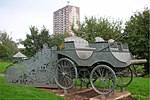The Battle of Saltley Gate was the mass picketing of a fuel storage depot in Birmingham, England, in February 1972 during a national miners' strike. When the strike began on 9 January 1972, it was generally considered that the miners "could not possibly win." Woodrow Wyatt, writing in the Daily Mirror, said: "Rarely have strikers advanced to the barricades with less enthusiasm or hope of success... The miners have more stacked against them than the Light Brigade in their famous charge." The picketing of the fuel depot – out of which tens of thousands of tons of coke fuel were being distributed nationwide – became a pivotal, and symbolic, event during the strike. Forcing its closure secured victory for the National Union of Mineworkers (NUM).Having closed every coal mine in the country, the miners' union sought to leverage its position by 'freezing' existing stockpiles of fuel in place, preventing them from being transported to the power stations, businesses and heavy industries that depended on them. By the beginning of February, the tactic was becoming effective and the Central Electricity Generating Board warned that power outages were imminent. The "last large accessible" stockpile of solid fuel in the country was held by a West Midlands Gas Board (WMGB) coke plant in Birmingham, where up to 700 vehicles were collecting fuel each day for supply to industry. WMGB argued that as they employed no miners they were not a party to the dispute and so should be allowed to continue supplying their customers. When news of mile-long queues of lorries waiting to collect fuel was published on 3 February in the Birmingham Mail, a small group of miners from nearby Staffordshire set up a picket line at the works.Their numbers proved ineffectual at persuading the lorry drivers to turn back, and Birmingham City Police sent hundreds of officers to ensure the depot gates were kept open. Within days, the Staffordshire pickets' request for assistance was answered by several thousand miners from South Yorkshire and South Wales. By 10 February, the number of pickets and protesters, bolstered by the arrival of unionised workers from other Birmingham industries, had reached upwards of 15,000, and Sir Derrick Capper, the Chief constable of Birmingham City Police, ordered the depot to close its gates "in the interests of public safety."The picketing and closure of the depot has been called "the miners' Agincourt", and brought one of its architects, Arthur Scargill — until then, "an obscure regional union official" — to national prominence as "a tribune of the working classes... hailed by the British magazine Harper's & Queen as one of Britain's leaders of the future."





